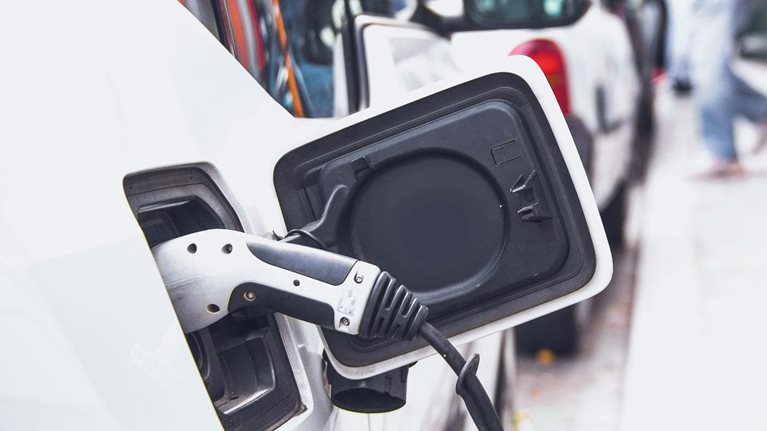The global electric-vehicle (EV) industry continues to expand rapidly. However, regional performance varies, with some EV markets approaching near-mainstream status, while others remain stuck in neutral. Overall, global EV-sales volumes are becoming large enough to create substantial profit pools for well-positioned suppliers and other upstream players—but they are also having a negative impact on traditional OEM profit margins. The entire power-train value chain continues to recalibrate as OEMs follow different sourcing strategies across e-power-train components and as many incumbents, plus new suppliers, enter the market. In the current highly competitive environment, the ultimate winners have yet to be determined. With the breakeven for EVs still a few years away, OEMs are feeling the heat. To accelerate and ensure sustainable, profitable growth, the industry still needs to overcome several challenges. (For more on the research underlying this article, see sidebar, “What is the Electric Vehicle Index?”)
Continued electric-vehicle growth through 2018
EV sales grew to more than two million units globally in 2018: an increase of 63 percent on a year-on-year basis, and a rate slightly higher than in prior years. Nevertheless, with a penetration rate of 2.2 percent, EVs still only represent a fraction of the overall light-vehicle market. The ratio of battery EVs (BEVs) to plug-in hybrid EVs (PHEVs) held relatively steady from 2017 (Exhibit 1).

Electric-vehicle-market snapshots
Regional performance varies considerably, with some EV markets approaching near-mainstream status, while others are simply marking time. A breakdown of EV-industry progress through 2018 by select countries or regions follows.
China leads
China’s EV market grew 85 percent over the prior year, significantly above the industry average. The market experienced healthy growth—despite a subsidy cut by the government, which significantly impeded sales of micro EVs that once represented around half of the Chinese EV market.
For BEVs in China in 2018, the minimum performance on electric range was increased to 150 kilometers (km), from 100 km, and the minimum performance on energy density rose to 105 watt-hours per kilogram (Wh/kg), from 90 Wh/kg. The government once more raised the bar for 2019, to 250 km and 125 Wh/kg, respectively. While last year, BEVs with a very high range and energy density benefited from an increase in subsidies, the government has now cut the incentives at all levels.
Standing at 1.1 million units, or 51 percent of global EV sales in 2018, China’s EV market is now about three times the size of the European and US markets each (Exhibit 2). With the government aiming to phase out subsidies entirely by next year, OEMs are in doubt that the market will be robust enough to sustain its growth beyond 2020. Furthermore, the trend toward an overall market decline (light-vehicle sales fell around 15 percent through May 2019 compared with last year) might also affect the EV segment going forward.

Europe’s mixed signals
The European EV market saw moderate growth (an increase of 90,000 units), with a mixed picture at the country level. Norway remains significantly ahead of other markets and appears on its way to mass-market adoption. Large markets (in absolute light-vehicle-unit sales terms) such as France, Germany, and the United Kingdom still have to gain momentum, with EV-market shares of around 2 percent, while comparably small Nordic countries, like Norway (40 percent market share), Iceland (17 percent), and Sweden (7 percent), currently perform the best. However, tightening CO2-emission regulation will most likely lead to significantly larger market shares for EVs across Europe through 2020–21 and beyond.
North America gets an electric-vehicle boost
The US market almost doubled to 360,000 EV units, mainly because of the strong sales performance of Tesla’s Model 3. Tesla sold 140,000 Model 3 cars in 2018, making it the best-selling EV in the United States (40 percent market share) and globally (7 percent). For the first time in the country, an EV model sold equally as well as comparable internal-combustion-engine (ICE) cars. While high sales numbers for the Model 3 in 2018 were partially supported by EV tax credits and high demand from the list of reservation holders, they still show that EVs can be attractive alternatives to gasoline-powered cars and that a strong market potential exists for a growing number of premium and mass-premium buyers. Nevertheless, sustainable market growth will also depend on regulatory developments, given ongoing discussions among federal and national parties regarding the rollback of 2025 fuel-economy standards as well as state authority under the Clean Air Act.
Japan follows a portfolio approach
Japan lost momentum from 2017, when sales increased by 142 percent driven by the introduction of a next-generation PHEV model. In 2018, the market declined by 9 percent compared with the year before, with EV penetration standing at only 1 percent. While Japanese OEMs were among the first movers with respect to the introduction of EVs, the country now lacks a strong push for more aggressive adoption. There has been some activity around BEVs recently, with Japanese OEMs moving from full hybrids and hydrogen fuel cells to pure battery-electric technology, as the former alternative-propulsion technologies struggle to win widespread global support.
India’s four-wheel market remains stalled, but two- and three-wheelers accelerate
The Indian EV market remains largely driven by mass- and low-cost-mobility segments, such as two- and three-wheelers. Recent government policies and those under debate could steeply accelerate electrification in these segments (for instance, differentiated tax policy promoting EVs and localized incentives to promote start-ups).
Would you like to learn more about the McKinsey Center for Future Mobility?
In addition to such regulatory tailwinds, product innovation in the form of new two- and three-wheel EV models rolling out each year (using longer-range lithium-ion batteries) and new business models, such as battery swapping, are having an impact. On the other hand, four-wheel EV sales have been almost unnoticeable so far, with fewer than 2,000 units sold in 2018 out of a total light-vehicle sales volume of four million units. Insufficient four-wheel consumer-focused government incentive schemes, limited models, price-sensitive consumers, and a lack of charging-infrastructure investment (public or private) are persistent challenges. Benchmarking policies focused on what other markets are doing could improve this situation, as could increases in EV imports while domestic players retool for EV production. This year, the government announced plans to order ride-hailing companies to convert 40 percent of their fleets to electric by 2026.
The global outlook for electric vehicles
Tesla is now the world’s largest EV producer, followed by two Chinese automakers, BYD and BAIC Motor. However, industry observers project that in 2019 and 2020, the intensity of competition will heat up significantly, with competitive models launched by several international premium brands. Overall, international OEMs are expected to launch 66 EV models in 2019 and 101 models in 2020, including several models in larger D and E segments—as well as SUVs and crossovers (Exhibit 3). These launches are part of a bigger strategy, as automakers need to comply with increasingly stringent CO2-emission regulations in Europe as well as Corporate Average Fuel Consumption (CAFC), New-Energy Vehicle (NEV), and other regulations in China.

The industry needs the emission relief EVs provide—especially in Europe, where average industry fleet emissions did not decrease for two consecutive years in 2016 and 2017. In addition, the European Union agreed last year—as the first market globally—to commit to even more stringent CO2-emission targets through 2030, aiming to reduce CO2 emissions by 37.5 percent from 2021 to 2030.
In China, the industry in aggregate overachieved its 2018 CAFC target of 6.3 liters per 100 km, while several international joint-venture companies and imported brands missed their individual targets (offset by positive credits carried over from past years). The enforcement of the EV-credit-quota system in 2019 and 2020, as well as the increasing stringency of CAFC targets, should support rapid EV growth. International OEMs should catch up on CAFC progress because of an increase in EV sales through new-model launches, although they may benefit less from government purchases.
Challenges to overcome to scale electric vehicles
While EV manufacturers continue to make progress in developing EVs with greater range, more power, and superior styling, the industry still needs to overcome several challenges to accelerate growth and scale EVs in a sustainable way.
Making bold choices to accelerate electric-vehicle profitability
Automotive-OEM-profitability compression because of EVs and other advanced technology is now a top concern for management: EV investments ramp higher each year, and increasing losses are tied to negative margins for most EV models sold in 2018. However, if OEMs pull the right levers, there are options to make EVs profitable. In the short term to midterm, these include redesigning EVs with new approaches to content trade-offs, expanding partnerships with mobility players, and making bolder moves to partner with competing OEMs on platform development and manufacturing. For a deep dive on the topic, see our article “Making electric vehicles profitable.”
Synchronizing the electric-vehicle value chain
Across these different markets, we continue to find that OEM strategies to develop and promote EVs are not always in sync or well supported by all players in the e-mobility ecosystem. Recent shortages in battery-cell production leading to long waiting periods for some EVs in Europe is just one example. An integrated approach across industries and government leaders would ease the burden. For example, greater clarity with respect to national-and-city-level emissions and air-quality regulations through 2030 would help to do three things: provide greater ability to plan necessary investments in new mining production for raw materials, such as nickel and cobalt; ramp up localized battery-cell production with room to grow; and improve OEM volume planning. Similarly, the coordination of renewables ramp-up to meet greater electricity demand, potentially paired with second-life EV batteries to avoid peak-load strains on the grid, could be another “unlock.” For further information, see our publications Race 2050—a vision for the European automotive industry and “Second-life EV batteries: The newest value pool in energy storage.”
Further expanding the model range
Despite the numerous model launches announced by international automakers for 2019–20, the available options still skew predominantly toward higher-priced premium vehicles. Mass-market EV choices that are competitively priced with existing volume-brand ICE vehicles are currently slated to hit the showrooms later. Accelerating availability of small, affordable vehicles will be especially important in early-stage price-sensitive EV markets, such as Brazil and India. More affordable options will also be critical for tapping into demand in mobility services—for example, independent ride-hailing drivers.

Reimagining mobility
In markets such as China, small BEVs are frequently nearing—or at—purchase-price parity with ICE vehicles, especially with subsidies, and they are cheaper on a total-cost-of-ownership basis. Markets like the United States, which is heavily skewed toward large-vehicle demand, will need to take a different approach with models that can go head to head with today’s crossovers and SUVs. Higher-range expectations for these vehicles may force OEMs to pursue greater scale at a global platform level and to partner up to drive costs down in batteries, e-motors, and other power electronics.
Industry and government can also collaborate to make strides in the decarbonization of transport and equipment and the improvement in air quality in cities through greater investments in, and promotion of, e-buses, EV commercial vehicles or e-trucks, and off-highway electrification (for example, in construction equipment and material handling). If the expected total-cost-of-ownership benefits in energy and maintenance costs are borne out in the test fleets rolling out across the globe from 2019 to 2022, we expect the pace of adoption to increase sharply in these vehicle types, as the economic benefits for businesses will be hard to ignore. For further information, see our articles “Harnessing momentum for electrification in heavy machinery and equipment” and “Fast transit: Why urban e-buses lead electric-vehicle growth.”
The global EV industry has accomplished major achievements in a relatively short time, driven by regulatory pressure, strong technical innovation in batteries, and increasing investment in EV platforms. But as EV markets continue their rapid but sometimes unpredictable growth toward mass-market proportions, automakers have begun to experience growing pains in their supply chains and in their bottom-line results. Fortunately, long-term cost trends continue to head downward, and in the near term, there are still many levers that the industry can pull. However, solutions for OEMs will require bolder moves, new design and business-model thinking, and better collaboration with suppliers, governments, fleets, and even competitors. For an industry that typically plans in two or three five-year product cycles, we may now be roughly one product cycle away from a more sustainable automotive market, with respect to both carbon footprint and OEM economics.



